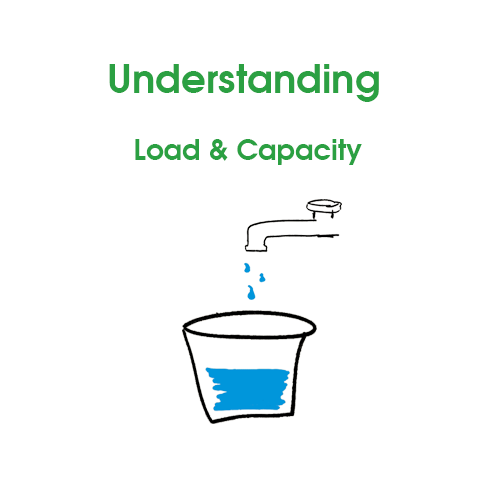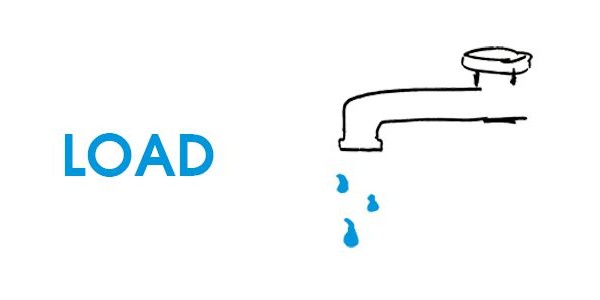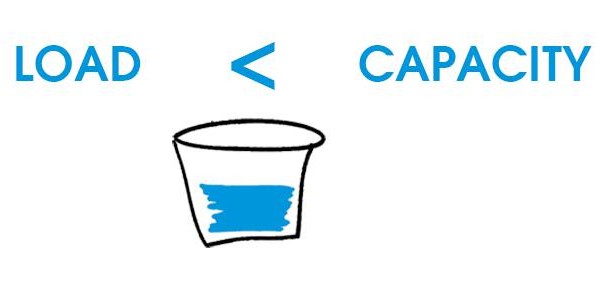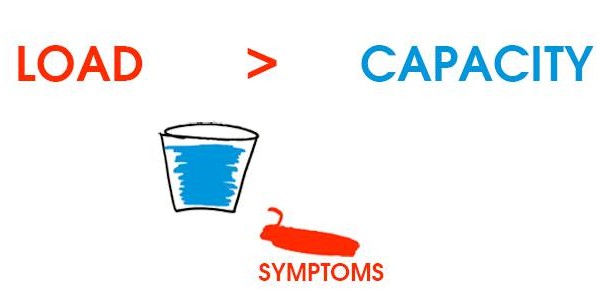
11 Aug You’re In Pain: You’d Better Understand Load and Capacity
Understand these two words and you have understood ALL musculoskeletal pain. Load and Capacity.
Ignore them and you could be getting the best treatment in the entire world for your pain and get ZERO results.
Defining Words – Load and Capacity
Before we go any further, it’s important for us to define words so we’re all on the same page.
Capacity is the work you’re able to do. Your capacity is like a bucket.
Examples of capacity include: I have the ability to run 5 miles, squat 500 pounds, do 30 leg extensions at 20 pounds of resistance, sit for an hour without pain, or play with my child for three hours without issue.
Load: work you do. Load is like water that you fill up your bucket with.
Examples of load include: The workout I did today included running 1 mile, then squatting for 50 repetitions, and then running a mile. Or the movement activities I did today included sitting for 6 hours today, reading for 2 hours, and walking for 4 hours.
As long as you live on Planet Earth, which has a Law of Universal Gravitation and a gravitational constant, you can’t escape loading your body. Although you can minimize load.
Symptoms: a smart response by the body letting us know when load > capacity. When symptoms are experienced, a body part is being damaged and is trying to protect itself by letting your conscious mind know “Houston, we have a problem.” Turn the faucet off! See the Load > Capacity image below.
Symptoms in the context of musculoskeletal disorders include but are not limited to the following sensations: achey, burning, stabbing, throbbing, sharp, tender, or abnormal stretching or tension.
You have no symptoms.
When load is LESS than your capacity and all of the water fits inside of your bucket, you are living a lifestyle that is currently congruent with your capacity. You don’t have any musculoskeletal symptoms (pain, abnormal tension during a stretch, or any other sensation of the body).
You have symptoms.
When load EXCEEDS your capacity and water overflows out of your bucket, you are living a lifestyle that is currently more demanding than your capacity will allow. Injury sets in and you have musculoskeletal symptoms.
Pain is the signal, letting you know, that you’re overflowing.
The simple answer to what is causing your pain is that you overloaded your body.
Reflection For You
Here you are, reading this.
- Are you in pain? If yes, where?
- Do you know what tissue or body part is overloaded? Have you had a correct and comprehensive diagnosis for your symptoms?
- How long have you been in pain?
- Have you been ignoring your pain, loading your body by keeping the water faucet on causing further damage to your body?
- Or have you been smartly listening to your body’s signals and taking action steps towards repairing the damaged tissue?
- If you’re not in pain, are you wondering how you can gain greater ability and capacity to do what you want in life, whether it is running a marathon, picking up your grandchildren as an eighty year old, or doing your favorite hobby such as gardening? Stay tuned …
Take Home Message: If you’re in pain, stop the faucet and give your body a chance to heal. Keeping the faucet on and continuing to use damaged tissue will only damage your body worse and make it much harder to recvoer from. If you’re not in pain, ask yourself how you might work on creating a bigger bucket to handle the demands of life should life ever ask more of you.
Disrespecting load and capacity will never result in a healthier, fitter body.
In the next post, we discuss what causes your capacity (or bucket) to be smaller than you want it to be.
 Comment below: How do you break the rules of load and capacity? How long has your body been telling you to listen?
Comment below: How do you break the rules of load and capacity? How long has your body been telling you to listen?





Greg Maynes
Posted at 02:49h, 18 AugustGreat article with clear examples. Made perfect sense in treatment last week, and easy to explain to others when describing the cause of my knee injury. Nicely done!
christopher
Posted at 13:23h, 18 AugustGreg, thank you for your kind words. The more we are all on the same page, the healthier, fitter, and pain-free we can all become. Your support means a lot!
2 Steps You Must Take When You're in Pain: About Symptoms
Posted at 16:42h, 21 September[…] you haven’t already fully grasped the concepts of load and capacity, you need […]
A Holistic (and Effective) Approach to Chronic Pain Resolution: Respecting Dysfunction
Posted at 09:50h, 01 October[…] Load is work you do. […]
Know Your Numbers: Standards for Musculoskeletal Health, The Low Back, And The Touch Your Toes Test
Posted at 22:48h, 10 January[…] Your tissue/joints are strong enough to load the correct structures of the mechanical […]
Know Your Numbers: Ankle Pain, Foot Pain, and Ankle Dorsiflexion Test
Posted at 19:50h, 15 January[…] the majority of the day, even when you’re not exercising, running, jumping, or lifting. The load faucet, due to the nature of ankles, drips into your capacity bucket all day long when you’re on […]
The Skinny on CrossFit Injuries - Healthy, Then Injured - Part 1
Posted at 18:07h, 15 March[…] load exceeds capacity, your body gets injured and expresses itself with symptoms through the conscious […]
Barefoot Rehab | Able at 80 – A New Paradigm of Fitness
Posted at 18:13h, 17 May[…] moving, but don’t put more water (load or work) in your bucket (capacity or fitness) than it will […]
Barefoot Rehab | The Real Cost of Your Health Care Choices: Avoiding the Medical Merry-Go-Round
Posted at 22:55h, 22 May[…] Pain: 6 – The pain has increased a bit as you’ve continued to load (or use) your damaged body […]
Barefoot Rehab | Pain Behind Knee: The ‘Ol Wallet-In-Door Syndrome
Posted at 19:09h, 26 May[…] any load (or […]
Are your Gears Grinding: Hip Flexor Pain or Hip Impingement?
Posted at 19:35h, 09 June[…] As always, all of the above conditions are caused by overload, or too much water in the damaged tissue’s bucket. […]
Know Your Numbers: The Lunge Stretch Test
Posted at 14:26h, 15 June[…] trying to stretch this tissue without increasing flexibility in the proper tissues and putting load on joints that don’t want it, leading to potential disc and cartilage problems or premature […]
Matt
Posted at 16:48h, 02 DecemberAs an engineer, I love the load vs. capacity analogy!
However, the symptoms you describe (that result from Load> Capacity) focus on pain.
My problem, due to pinched nerves, diabetes is ruled out) is that when I over-load my poor-dorsiflexion/over-pronating structure, I don’t feel the pain that would alert me to stop loading (walking/working in yard, soccer).
My symptom is only visual – at end of day when take off shoes and sox and see a blister.
I wish I could rely on the early warning system of pain.
Thanks
Dr. Chris
Posted at 00:50h, 28 JanuaryMatt, that’s a sign (objective), not a symptom (which is subjective).
If your joints are fairly healthy, you can keep “oveerloading” them until they can’t take it anymore. Then, they’ll let you know with pain.
This is why technique and form are so important.
Top 5 Ways to Prevent Adhesion (In the Muscles) From Building Up (Or Coming Back)
Posted at 15:15h, 29 February[…] For an in-depth discussion of Water in Your Bucket, check out out Load and Capacity post. […]